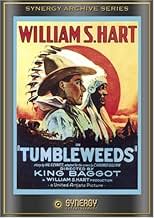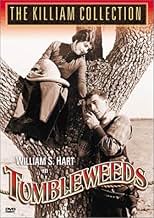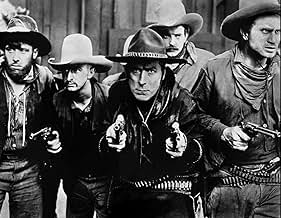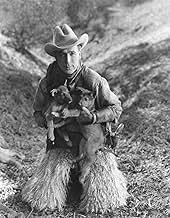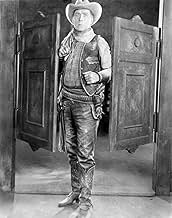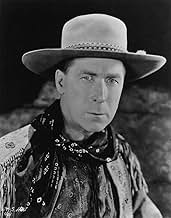CALIFICACIÓN DE IMDb
6.6/10
737
TU CALIFICACIÓN
El gobierno concederá una franja de terreno a los colonos que quieran vivir y trabajar allí. La señal de partida será un disparo que iniciará la carrera hacia los mejores campos y concesione... Leer todoEl gobierno concederá una franja de terreno a los colonos que quieran vivir y trabajar allí. La señal de partida será un disparo que iniciará la carrera hacia los mejores campos y concesiones.El gobierno concederá una franja de terreno a los colonos que quieran vivir y trabajar allí. La señal de partida será un disparo que iniciará la carrera hacia los mejores campos y concesiones.
- Dirección
- Guionistas
- Elenco
William S. Hart
- Don Carver
- (as Wm. S. Hart)
- …
Richard Neill
- Bill Freel
- (as Richard R. Niell)
George F. Marion
- Old Man
- (as George Marion)
Taylor N. Duncan
- Cavalry Major
- (as Ted Duncan)
Nora Cecil
- Pioneer Mother
- (sin créditos)
Nino Cochise
- Indian
- (sin créditos)
Monte Collins
- Hicks
- (sin créditos)
Fred Gamble
- Hotel Proprietor
- (sin créditos)
George Marion
- Homesteader
- (sin créditos)
Apache Bill Russell
- Indian
- (sin créditos)
- Dirección
- Guionistas
- Todo el elenco y el equipo
- Producción, taquilla y más en IMDbPro
Opiniones destacadas
In 1925 when TUMBLEWEEDS was released, William S. Hart was 60 years old and been had supplanted at the box office by a host of cowboy stars like Tom Mix who were much flashier and far less realistic. Hart wanted to go out on top and that is just what he did. TUMBLEWEEDS is set in 1893 during the opening of the Cherokee Strip and his recreation of the mad scramble for the newly opened up Indian lands is a landmark in cinema history which has been copied many times but without the same sense of immediacy that is depicted here.
All the elements of earlier Hart westerns are here, the shy hero, the woman in distress, the 19th century code of honor (Hart was born in 1865), rugged action sequences involving Hart and above all the rugged natural locations of a now vanished West. The production values are high, the photography splendid, and the supporting cast top notch especially Barbara Bedford as Hart's love interest Molly. Bedford played strong independent women during her brief career most notably in the 1920 LAST OF THE MOHICANS.
This new DVD release is an enhanced copy of the old Killiam Collection VHS version that has been around for a while but it has never looked this good. Also included is the 1939 eight minute prologue that Hart did for the film's reissue. Hart was 74 by this time and his recounting of the making of his films and the Old West that he knew is not only informative but also quite poignant. This film is his lasting legacy, a legacy that stretches from Gary Cooper to Clint Eastwood, and it's great to have it on DVD at last...For more reviews visit The Capsule Critic.
All the elements of earlier Hart westerns are here, the shy hero, the woman in distress, the 19th century code of honor (Hart was born in 1865), rugged action sequences involving Hart and above all the rugged natural locations of a now vanished West. The production values are high, the photography splendid, and the supporting cast top notch especially Barbara Bedford as Hart's love interest Molly. Bedford played strong independent women during her brief career most notably in the 1920 LAST OF THE MOHICANS.
This new DVD release is an enhanced copy of the old Killiam Collection VHS version that has been around for a while but it has never looked this good. Also included is the 1939 eight minute prologue that Hart did for the film's reissue. Hart was 74 by this time and his recounting of the making of his films and the Old West that he knew is not only informative but also quite poignant. This film is his lasting legacy, a legacy that stretches from Gary Cooper to Clint Eastwood, and it's great to have it on DVD at last...For more reviews visit The Capsule Critic.
After a while, watching "Tumbleweeds" starts to feel like homework. The movie wore me down after a while. I've seen a lot of silent movie comedies. Many of them aged quite well. As for as dramas go, I haven't seen nearly as many. For me they haven't aged as well. They are a lot harder to watch than the comedies. Add into the mix a very stiff (and seemingly self-serious) William S. Hart and "Tumbleweeds" doesn't stand a chance. There are a few laughs and some exciting action but they are too few and far between. "Tumbleweeds" is okay but it feels a lot longer than its actual running time.
Once it was among the most popular movies of its kind, and now it's generally remembered only by silent movie fans, but "Tumbleweeds" is a classic silent Western that's still worth seeing. To be sure, a lot of its appeal now comes from nostalgia, but in its time it was close to the top of its genre.
The opening scenes start the story nicely, and they also give it some thoughtful overtones, with cowboys Hart and Lucien Littlefield coming to realize their role as "Tumbleweeds" in a changing world. The 'tumbleweed' image is used well in developing Hart's character, as he faces the consequences of the land rush and of the personal affairs he gets involved in. The story itself has a lot of familiar elements, without many surprises, but the atmosphere and the characters are enough to carry it.
The land rush sequence is probably the most exciting part of the movie, and it is quite a fine set piece. It's later followed by a fast-paced climactic chase that also works well. The action makes a good complement to the atmosphere of the changing frontier, making it a movie that fits together nicely, and that still works pretty well.
The opening scenes start the story nicely, and they also give it some thoughtful overtones, with cowboys Hart and Lucien Littlefield coming to realize their role as "Tumbleweeds" in a changing world. The 'tumbleweed' image is used well in developing Hart's character, as he faces the consequences of the land rush and of the personal affairs he gets involved in. The story itself has a lot of familiar elements, without many surprises, but the atmosphere and the characters are enough to carry it.
The land rush sequence is probably the most exciting part of the movie, and it is quite a fine set piece. It's later followed by a fast-paced climactic chase that also works well. The action makes a good complement to the atmosphere of the changing frontier, making it a movie that fits together nicely, and that still works pretty well.
Seen in a 16mm print from the 1939 release (not necessarily the 1975 restoration listed by imdb), the sheer sincerity of the film-makers appealed highly. Intelligent art-gallery audience loved it - shown on 40th anni of Hart's death. Sound was coarse (expected) but loud and consistent in quality with image
Just from reading about him, I became a fan of William S. Hart before I ever saw one of his movies.
When I moved to Los Angeles, I made a pilgrimage to the late lamented Silent Movie Theatre on Fairfax, not only to see whatever silent films there might be available, but to plead for a chance to see any Hart film, and especially "Tumbleweeds," about which I had read so much.
Alas, the Hamptons, owners of the Theatre, never did show it, but I was able to rent a 16 mm print and show it myself, in my tiny living room.
It was all I had hoped. It was, and is, magnificent.
Character development was nigh onto perfect, and the intertitles by C. Gardner Sullivan, surely one of the greatest of such writers, merely enhanced the beauty of the presentation.
Oh, but there is more: Camera angles were brilliantly formatted. Only later did I learn that Mr. Hart himself was co-director.
William S. Hart (http://www.imdb.com/name/nm0366586/?ref_=fn_al_nm_1) was born a city slicker but, like me, I guess, he fell in love with the West and its mystique. He wanted to share that love with everyone, and for too few years presented the mythology.
You can find his spoken farewell at YouTube (https://www.youtube.com/watch?v=_BlgWP3Airs), and if you're really lucky you will find a copy of "Tumbleweeds" with that farewell used as a prologue. It still moves me to tears.
One reason I cry is that, listening to him, I think how great a talkie actor he could have been, with that voice; and I think what a loss to those of us who love Westerns generally and who love William S. Hart in particular.
"Tumbleweeds" is a classic, regardless of genre.
It is poetry on film, a magnificent motion picture.
When I moved to Los Angeles, I made a pilgrimage to the late lamented Silent Movie Theatre on Fairfax, not only to see whatever silent films there might be available, but to plead for a chance to see any Hart film, and especially "Tumbleweeds," about which I had read so much.
Alas, the Hamptons, owners of the Theatre, never did show it, but I was able to rent a 16 mm print and show it myself, in my tiny living room.
It was all I had hoped. It was, and is, magnificent.
Character development was nigh onto perfect, and the intertitles by C. Gardner Sullivan, surely one of the greatest of such writers, merely enhanced the beauty of the presentation.
Oh, but there is more: Camera angles were brilliantly formatted. Only later did I learn that Mr. Hart himself was co-director.
William S. Hart (http://www.imdb.com/name/nm0366586/?ref_=fn_al_nm_1) was born a city slicker but, like me, I guess, he fell in love with the West and its mystique. He wanted to share that love with everyone, and for too few years presented the mythology.
You can find his spoken farewell at YouTube (https://www.youtube.com/watch?v=_BlgWP3Airs), and if you're really lucky you will find a copy of "Tumbleweeds" with that farewell used as a prologue. It still moves me to tears.
One reason I cry is that, listening to him, I think how great a talkie actor he could have been, with that voice; and I think what a loss to those of us who love Westerns generally and who love William S. Hart in particular.
"Tumbleweeds" is a classic, regardless of genre.
It is poetry on film, a magnificent motion picture.
¿Sabías que…?
- Trivia(at around 1h 7 mins) Just after the locked-up "Sooners" rush Dan Carver, who is cutting through a rail, the scene shifts to a team of horses pulling a wagon. The right "off" wheeler horse can be seen to go lame but continue running with a noticeable limp.
- Citas
Don Carver: Boys - it's the last of the West.
- Versiones alternativasThe 1939-reissued version was preceded by an eight-minute sound prologue with William S. Hart introducing the film.
- ConexionesFeatured in The Great Chase (1962)
Selecciones populares
Inicia sesión para calificar y agrega a la lista de videos para obtener recomendaciones personalizadas
Detalles
Taquilla
- Presupuesto
- USD 312,000 (estimado)
- Tiempo de ejecución
- 1h 18min(78 min)
- Mezcla de sonido
- Relación de aspecto
- 1.33 : 1
Contribuir a esta página
Sugiere una edición o agrega el contenido que falta

